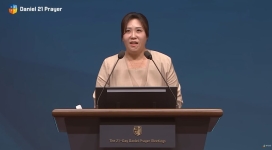Nestorian Christians first entered China in 635AD along the Silk Route via northwest China. The church they established was largely among foreign groups, rather than the Chinese.
Thereafter Christian influence waxed and waned, often absent for centuries before fresh initiatives were taken. Matteo Ricci, a Jesuit priest, obtained permission to live in China in 1583. However, despite planting a church, he still did not make Christianity a Chinese religion. The dominant religions in China remained Confucianism (more a moral philosophy than a religion), Taoism and Buddhism.
Protestant missions were latecomers to China, traveling on the same boats that brought Western trade and imperialism. Missions established themselves along the east coast in the mid-19th century.
James Hudson Taylor, founder of the China Inland Mission (now OMF International) in 1865, saw the needs of the inland provinces and he and others moved away from the coast, establishing churches and hospitals. At this time, work among minority peoples like the Lisu in western China also began.
By 1949 there were about 6,000 missionaries in China and 20,000 Protestant churches with over a million members. Christianity was established, though not accepted as an indigenous faith.
The Communist party in the 1960s attempted to eliminate organized religion. The Chinese church was isolated and forced underground as the missionaries left. Church buildings were closed and pastors and congregations were imprisoned and persecuted. To the outside world it was difficult to imagine how the church would survive this oppression.
However, as China emerged after Mao’s death, evidence of a thriving church was revealed, sustained by God’s grace through the faithfulness of Chinese believers, the prayers of Christians abroad and radio broadcasts.
In 1979 Deng Xiaoping allowed churches to re-open under the control of the TSPM (Three Self Patriotic Movement). The church then had about 1 million members.
The TSPM has seen a growth in membership across China over the last 20 years. Official reports admit to over 10 million Christians in China.
However, many Chinese Christians refuse to align themselves with the official church, seeing it as too much under the authority of the Communist government; serving the Party first and God second. Instead they meet in house churches; some isolated, others part of well-organized groups numbering hundreds of thousands.
Although figures vary, a realistic estimate for the total number of Protestant Christians in China would be 50 million. Thirty million copies of the Bible have been printed there.
The house church movement is at present under great pressure to register with government authorities. Reports over the last five years reveal that incidents of persecution are common. Pastors are imprisoned, materials are confiscated and meetings closed down.
While Muslim minority peoples such as the Uygur, Kazakhs, and Kirgiz (around 20 million in number) now practise their religion openly, it is illegal to spread the gospel to anyone under 18 years old (about 400 million people).
The struggle to establish Christianity in China is by no means over. Support and prayer for the church is as important as ever.
Population
• Total: 1,271,000,000.
• Shanghai: 15 million.
• Beijing: 13 million.
• Density: 132 per sq km.
• 92% ethnic Han Chinese.
• 102,000,000 people in 55 different ethnic minorities.
• Population growth has been controlled by the government promoting late marriages and requiring parents to have only one child. Abortion is legal.
• China is 60% rural, with an increasing migration of workers to urban areas.
• Most of the population lives in the east ?the historical heartland of China ?so density is greater than statistics suggest.







